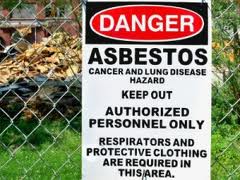Asbestos is the commercial name given to six naturally occurring fibers. These six fibers belong to two subgroups (amphibole and serpentine), each differing in chemical formula and physical properties.
All types share the property of mutagenicity (i.e., being able to induce malignant transformations in the deoxyribonucleic acid (DNA) of exposed cells). It is well established that all forms of asbestos are carcinogenic.
Crocidolite (blue asbestos) was found in Africa in the early part of the 19th century, and amosite (brown asbestos) was discovered in South Africa. Amphibole forms of asbestos predominate as they are able to penetrate deeper into the lung. A chronic foreign body reaction develops with resultant interstitial fibrosis due to a chronic inflammatory response. Crocidolite and amosite are two of the five amphibole types of asbestos, and they have the greatest potential for human health damage.
Chrysotile (white asbestos), the only serpentine mineral in this group, was discovered in 1876 in Quebec, Canada. It is capable of inducing multiple malignancies in persons exposed. According to the U.S. EPA, chrysotile accounts for approximately 95% of asbestos found in buildings in the United States.
Over 3,000 asbestos containing products have been used primarily as fire retardants and to insulate wiring and plumbing in homes, schools, offices and industrial plants. However, asbestos has been used in many other products.
Sources of Exposure
While most exposure occurs with those who mine, fashion or use asbestos professionally, exposure from buildings can also occur. Asbestos fibers remain in the materials in which they are used, but aging can cause these materials to become friable and release respirable fibers into the air. It has also been found in drinking water due to the erosion of natural deposits, leaching from asbestos in landfills and the deterioration of asbestos-containing pipes.
Remodeling or renovations of buildings further disrupts these materials and allow asbestos fibers to infiltrate the air of indoor spaces. The most common diseases associated with chronic exposure to asbestos are asbestosis and pleural abnormalities (mesothelioma, lung cancer). Cancers associated with asbestos exposure affect the lungs, larynx, ovaries, pharynx, stomach, colorectum and other organs.
Status of Asbestos Bans
In the late 1970s, it was discovered that the industry had been aware, for more than 40 years, of the many health hazards of asbestos. Sound familiar? This is another example of Big Business hiding the truth about the dangers of their products---just like the tobacco companies hid the truth about the dangers of tobacco for more than 50 years.
Asbestos has been banned in 55 countries worldwide. Some of the recent announcements include:
- Canada issued new regulations under the Canadian Environmental Protection Act and updates to national building codes that will ban asbestos and asbestos-containing products by 2018.
- The President of Sri Lanka announced a total ban would take place in 2018.
- The Ministry of Commerce in Oman announced their decision to “ban the import of asbestos was to ensure that no product which contains asbestos, or was manufactured with asbestos, would enter the country.”
In the United States, asbestos is banned for “new uses” (products that have not historically contained asbestos), and certain asbestos-containing products (such as corrugated paper, rollboard, commercial paper, specialty paper and flooring felt) or asbestos-containing uses (such as asbestos pipe insulation and spray-applied asbestos materials).
However, asbestos has not
been fully banned in the U.S. or in other countries such as China, Russia, India, Singapore, Taiwan, Mongolia and Ukraine.
